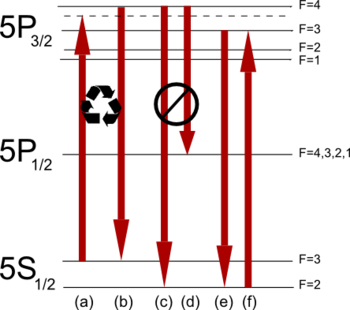Laser cooling
Laser cooling refers to a number of techniques in which atomic and molecular samples are cooled down to near absolute zero through the interaction with one or more laser fields. All laser cooling techniques rely on the fact that when an object (usually an atom) absorbs and re-emits a photon (a particle of light) its momentum changes. The temperature of an ensemble of particles is larger for larger variance in the velocity distribution of the particles. Laser cooling techniques combine atomic spectroscopy with the aforementioned mechanical effect of light to compress the velocity distribution of an ensemble of particles, thereby cooling the particles.

| 1 | A stationary atom sees the laser neither red- nor blue-shifted and does not absorb the photon. |
|---|---|
| 2 | An atom moving away from the laser sees it red-shifted and does not absorb the photon. |
| 3.1 | An atom moving towards the laser sees it blue-shifted and absorbs the photon, slowing the atom. |
| 3.2 | The photon excites the atom, moving an electron to a higher quantum state. |
| 3.3 | The atom re-emits a photon. As its direction is random, there is no net change in momentum over many absorption-emission cycles. |
The first example of laser cooling, and also still the most common method (so much so that it is still often referred to simply as 'laser cooling') is Doppler cooling. Other methods of laser cooling include:
- Sisyphus cooling[1]
- Resolved sideband cooling
- Raman Sideband Cooling
- Velocity selective coherent population trapping (VSCPT)[2]
- Cavity mediated cooling [3]
- Use of a Zeeman slower
- Electromagnetically induced transparency (EIT) cooling[4]
Doppler cooling

Doppler cooling, which is usually accompanied by a magnetic trapping force to give a magneto-optical trap, is by far the most common method of laser cooling. It is used to cool low density gases down to the Doppler cooling limit, which for Rubidium 85 is around 150 microkelvin.
In Doppler cooling, the frequency of light is tuned slightly below an electronic transition in the atom. Because the light is detuned to the "red" (i.e., at lower frequency) of the transition, the atoms will absorb more photons if they move towards the light source, due to the Doppler effect. Thus if one applies light from two opposite directions, the atoms will always scatter more photons from the laser beam pointing opposite to their direction of motion. In each scattering event the atom loses a momentum equal to the momentum of the photon. If the atom, which is now in the excited state, then emits a photon spontaneously, it will be kicked by the same amount of momentum, but in a random direction. Since the initial momentum change was a pure loss (opposing the direction of motion), while the subsequent change was random (i.e., not pure gain), the overall result of the absorption and emission process is to reduce the momentum of the atom, therefore its speed — provided its initial speed was larger than the recoil speed from scattering a single photon. If the absorption and emission are repeated many times, the average speed, and therefore the kinetic energy of the atom will be reduced. Since the temperature of a group of atoms is a measure of the average random internal kinetic energy, this is equivalent to cooling the atoms.
Uses
Laser cooling is primarily used to create ultracold atoms for experiments in quantum physics. These experiments are performed near absolute zero where unique quantum effects such as Bose-Einstein condensation can be observed. Laser cooling has primarily been used on atoms, but recent progress has been made toward laser cooling more complex systems. In 2010, a team at Yale successfully laser-cooled a diatomic molecule.[5] In 2007, an MIT team successfully laser-cooled a macro-scale (1 gram) object to 0.8 K.[6] In 2011, a team from the California Institute of Technology and the University of Vienna became the first to laser-cool a (10 μm x 1 μm) mechanical object to its quantum ground state.[7]
See also
- List of laser articles
- Optical tweezers
- Mössbauer effect
- Mössbauer spectroscopy
- Quantum refrigerators
- Timeline of low-temperature technology
- Researchers in laser cooling
References
- ↑ Laser cooling and trapping of neutral atoms Nobel Lecture by William D. Phillips, Dec 8, 1997. doi:10.1103/RevModPhys.70.721
- ↑ A. Aspect; E. Arimondo; R. Kaiser; N. Vansteenkiste; C. Cohen-Tannoudji (1988). "Laser Cooling below the One-Photon Recoil Energy by Velocity-Selective Coherent Population Trapping". Phys. Rev. Lett. 61: 826–829. Bibcode:1988PhRvL..61..826A. doi:10.1103/PhysRevLett.61.826.
- ↑ Peter Horak; Gerald Hechenblaikner; Klaus M. Gheri; Herwig Stecher; Helmut Ritsch (1988). "Cavity-Induced Atom Cooling in the Strong Coupling Regime". Phys. Rev. Lett. 79: 4974–4977. Bibcode:1997PhRvL..79.4974H. doi:10.1103/PhysRevLett.79.4974.
- ↑ Haller, Elmar; Hudson, James; Kelly, Andrew; Cotta, Dylan A.; Peaudecerf, Bruno; Bruce, Graham D.; Kuhr, Stefan. "Single-atom imaging of fermions in a quantum-gas microscope". Nature Physics. 11 (9): 738–742. arXiv:1503.02005
 . Bibcode:2015NatPh..11..738H. doi:10.1038/nphys3403.
. Bibcode:2015NatPh..11..738H. doi:10.1038/nphys3403. - ↑ E. S. Shuman; J. F. Barry; D. DeMille (2010). "Laser cooling of a diatomic molecule". Nature. 467: 820–823. arXiv:1103.6004
 . Bibcode:2010Natur.467..820S. doi:10.1038/nature09443. PMID 20852614.
. Bibcode:2010Natur.467..820S. doi:10.1038/nature09443. PMID 20852614. - ↑ Massachusetts Institute of Technology (2007, April 8). Laser-cooling Brings Large Object Near Absolute Zero. ScienceDaily. Retrieved January 14, 2011.
- ↑ Caltech Team Uses Laser Light to Cool Object to Quantum Ground State. Caltech.edu. Retrieved June 27, 2013. Updated 10/05/2011
Additional sources
- Atomic Physics. Foot, C.J. Oxford University Press (2005). Pdf
- Cohen-Tanoudji, Claude (2011). Advances in Atomic Physics. World Scientific. p. 791. ISBN 978-981-277-496-5. doi:10.1142/6631
- Bowley, Roger; Copeland, Ed (2010). "Laser Cooling". Sixty Symbols. Brady Haran for the University of Nottingham.
- Laser Cooling HyperPhysics